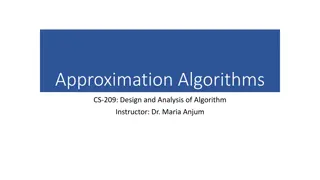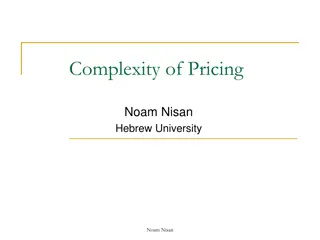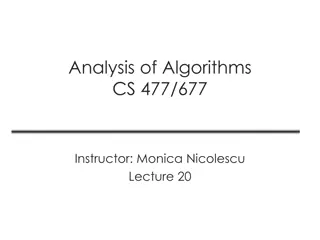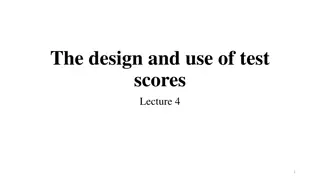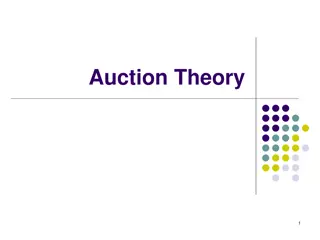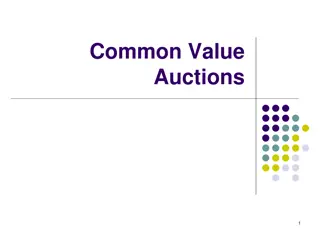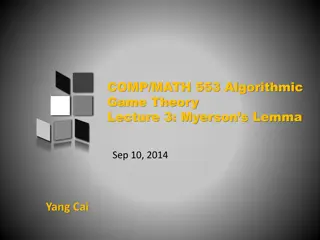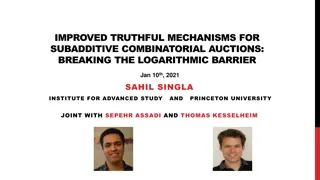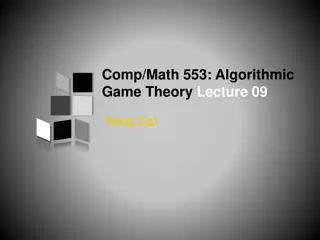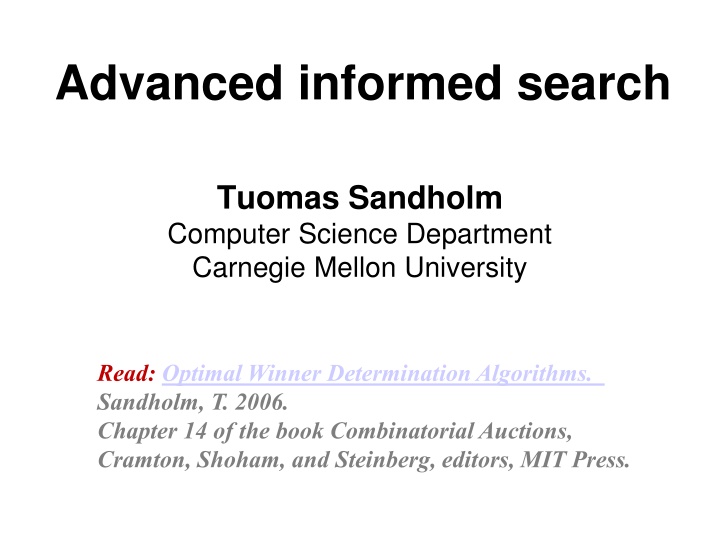
Optimal Winner Determination Algorithms in Multi-Item Auctions
This content delves into the intricacies of winner determination in multi-item auctions, exploring advanced informed search techniques and auction design strategies. It discusses the challenges of sequential and parallel auctions, as well as the concept of combinatorial auctions and NP-completeness. Various methods to optimize revenue and social welfare in auction settings are also examined in detail.
Uploaded on | 0 Views
Download Presentation

Please find below an Image/Link to download the presentation.
The content on the website is provided AS IS for your information and personal use only. It may not be sold, licensed, or shared on other websites without obtaining consent from the author. If you encounter any issues during the download, it is possible that the publisher has removed the file from their server.
You are allowed to download the files provided on this website for personal or commercial use, subject to the condition that they are used lawfully. All files are the property of their respective owners.
The content on the website is provided AS IS for your information and personal use only. It may not be sold, licensed, or shared on other websites without obtaining consent from the author.
E N D
Presentation Transcript
Advanced informed search Tuomas Sandholm Computer Science Department Carnegie Mellon University Read: Optimal Winner Determination Algorithms. Sandholm, T. 2006. Chapter 14 of the book Combinatorial Auctions, Cramton, Shoham, and Steinberg, editors, MIT Press.
Example application: Winner determination in multi-item auctions Auctioning multiple distinguishable items when bidders have preferences over combinations of items: complementarity & substitutability Example applications Allocation of transportation tasks Allocation of bandwidth Dynamically in computer networks Statically e.g. by FCC Sourcing Electricity markets Securities markets Liquidation Reinsurance markets Retail ecommerce: collectibles, flights-hotels-event tickets Resource & task allocation in operating systems & mobile agent platforms
Auction design for multi-item settings Sequential auctions How should rational agents bid (in equilibrium)? Full vs. partial vs. no lookahead Would need normative deliberation control methods Inefficiencies can result from future uncertainties Parallel auctions Inefficiencies can still result from future uncertainties Postponing & minimum participation requirements Unclear what equilibrium strategies would be Methods to tackle the inefficiencies Backtracking via reauctioning (e.g. FCC [McAfee&McMillan96]) Backtracking via leveled commitment contracts [Sandholm&Lesser95,AAAI-96, GEB-01] [Sandholm96] [Andersson&Sandholm98a,b] Breach before allocation Breach after allocation
Auction design for multi-item settings Combinatorial auctions [Rassenti,Smith&Bulfin82]... Bids can be submitted on combinations (bundles) of items Bidder s perspective Avoids the need for lookahead (Potentially 2#items valuation calculations) Auctioneer s perspective: Automated optimal bundling of items Winner determination problem: Label bids as winning or losing so as to maximize sum of bid prices (= revenue social welfare) Each item can be allocated to at most one bid Exhaustive enumeration is 2#bids
NP-completeness NP-complete [Rothkopf et al Mgmt Sci 98] Weighted set packing [Karp 72] [For an overview of worst-case complexity results of the winner determination problem, see review article by Lehmann, Mueller, and Sandholm in the textbook Combinatorial Auctions, MIT Press 2006 available at www.cs.cmu.edu/~sandholm]
Polynomial time approximation algorithms with worst case guarantees value of optimal allocation k = value of best allocation found General case Cannot be approximated to k = #bids1- (unless probabilistic polytime = NP) Proven in [Sandholm IJCAI-99, AIJ-02] Reduction from MAXCLIQUE, which is inapproximable [H stad96] Best known approximation gives k O(#bids / (log #bids)2 ) [Haldorsson98]
Solving the winner determination problem when all combinations can be bid on: Search algorithms for optimal anytime winner determination Capitalize on sparsely populated space of bids Generate only populated parts of space of allocations Highly optimized 1st generation algorithm: branch-on-items formulation [Sandholm ICE-98, IJCAI-99, AIJ-02; Fujishima, Leyton-Brown & Shoham IJCAI- 99] 2nd generation algorithm: branch-on-bids formulation [Sandholm&Suri AAAI-00, AIJ-03, Sandholm et al. IJCAI-01, MgmtSci-05] New ideas, e.g., multivariate branching [Gilpin & Sandholm IJCAI- 07, ]
First generation search algorithms: branch-on-items formulation [Sandholm ICE-98, IJCAI-99, AIJ-02] Bids: 1 2 3 4 5 1,2 1,3,5 1,4 2,5 3,5 1 1,2 1,3,5 1,4 2 3 2 3,5 2,5 2,5 2 4 4 4 3 3,5 3 3 3,5 3 5 5 4 4 4 Prop. Need only consider children that include item with smallest index among items not on the path Insert dummy bid for price 0 for each single item that has no bids => allows bid combinations that do not cover all items (seller can keep some items) Generates each allocation of positive value once, others not generated Complexity Prop. #leaves (#bids/#items)#items Proof. Let ni be the number of bids that include item i but no items with smaller index. #leaves max n1 n2 nm s.t. n1 + n2 + + nm = #bids. Max achieved at ni = n/m. Depth at most m. QED #nodes #items #leaves IDA* is 2 orders of magnitude faster than depth first search Anytime algorithm 5
2nd generation algorithm: Combinatorial Auction, Branch On Bids [Sandholm&Suri AAAI-00, AIJ-03] B A Bids of this example A={1,2} B={2,3} C={3} D={1,3} Bid graph A D C IN OUT B C B D C C OUT IN IN OUT C D C Finds an optimal solution Na ve analysis: 2#bids leaves OUT IN D D Thrm. At most leaves where k is the minimum #items per bid provably polynomial in bids even in worst case! IN OUT
Use of h-values (=upper bounds) to prune winner determination search f* = value of best solution found so far g = sum of prices of bids that are IN on path h = value of LP relaxation of remaining problem Upper bounding: Prune the path when g+h f*
Linear programming for computing h-values
Linear program of the winner determination problem aka shadow price
Linear programming Original problem Initial tableau maximize such that Slack variables Assume, for simplicity, that origin is feasible (otherwise have to run a different LP to find first feasible and run the main LP in a revised space) Simplex method pivots variables in and out of the tableau Basic variables are on the left hand side
Speeding up the use of linear programs in search If LP returns a solution where all integer variables have integer values, then that is the solution to that node and no further search is needed below that node Instead of simplex in the LP, use simplex in the DUAL because after branching, the previous DUAL solution is still feasible and a good starting point for simplex at the new node (see next slide) Thrm. LP optimum value = DUAL optimum value aka shadow price
Example showing DUAL is feasible at children Goods: {1,2,3}, Bids: <{1,2},$4>, <{1,3},$3>, <{2,3},$2> LP DUAL LP DUAL LP DUAL Root solution is no longer feasible (x2 > 0) Root solution is still feasible (for y4 = 0) Root solution is no longer feasible (x2 < 1) Root solution is still feasible (for any y4)
Cutting planes (aka cuts) Extra linear constraints can be added to the LP to reduce the LP polytope and thus give tighter bounds (less optimistic h-values) if the constraints are guaranteed to not exclude any integer solutions Applications-specific vs. general-purpose cuts Branch-and-cut algorithm = branch-and-bound algorithm that uses cuts A global cut is valid throughout the search tree A local cut is guaranteed to be valid only in the subtree below the node at which it was generated (and thus needs to be removed from consideration when not in that subtree)
Example of a cut that is valid for winner determination: Odd hole inequality E.g., 5-hole x8 x3 x2 No chord x1 x6 Edge means that bids share items, so both bids cannot be accepted x1 + x2 + x3 + x6 + x8 2
Separation using cuts LP optimum Valid cut that separates Valid cut that does not separate Invalid cut
How to find cuts that separate? For some cut families (and/or some problems), there are polynomial-time algorithms for finding a separating cut Otherwise, use: Generate a cut Generation preferably biased towards cuts that are likely to separate Test whether it separates
Gomory mixed integer cut Most powerful general-purpose cut for many problems Applicable to all problems, where constraints and objective are linear, the problem has integer variables and potentially also real variables Cut is generated using the LP optimum so that the cut separates
First, a simple version for problems with no real-valued variables [The above presentation is from Jeff Linderoth s slides] Amazing tidbit (which we will not use) Gomory s cutting plane algorithm: Integer program (not MIP) can be solved with no search by an algorithm that generates a finite number of these cuts. How many? A: Potentially exponentially many In each iteration: Generate a cut (LP tableau guides which cut is generated) Include a new slack variable corresponding to that cut Optimize the new LP (e.g., using dual simplex algorithm) Rules against cycling in LP solving are needed to guarantee optimality in a finite number of steps E.g., http://www.math.unl.edu/~shartke2/teaching/2008f432/Handout_Gomory.pdf While this algorithm has been viewed as a mere curiosity, it has very recently shown promise on some practical problems (the choice of anti-cycling rule is key for speed in practice).
Derivation of Gomory mixed integer cut Input: one row from optimal LP tableau: Fractional, basic, not a slack, integer variable Non-basic. Integer. Continuous. Define: Rewrite tableau row: Idea: RHS above has to be integral. All integer terms add up to integers, so: LHS and RHS differ by an integer
Back to search for winner determination
Formulation comparison A branching decision in the branch-on-bids formulation locks in only one bid (and on the IN branch also its neighbors) in the branch-on-items formulation locks in all bids that include that item The former follows the principle of least commitment More flexibility for further decision ordering (choice of which decision to branch on in light of the newest information)
Structural improvements to search algorithms for winner determination Optimum reached faster & better anytime performance Always branch on a bid j that maximizes e.g. pj / |Sj| (presort) Lower bounding: If g+L>f*, then f* Identify decomposition of bid graph in O(|E|+|V|) time & exploit g+L Pruning across subproblems (upper & lower bounding) by using f* values of solved subproblems and h values of yet unsolved ones Forcing decomposition by branching on an articulation bid All articulation bids can be identified in O(|E|+|V|) time Could try to identify combinations of bids that articulate (cutsets)
Question ordering heuristics In depth-first branch-and-bound, it is sometimes best to branch on a question for which the algorithm knows a good answer with high likelihood Best (to date) heuristics for branching on bids [Sandholm et al. IJCAI-01, MgmtSci-05]: A: Branch on bid whose LP value is closest to 1 B: Branch on bid with highest normalized shadow surplus: Choosing the heuristic dynamically based on remaining subproblem E.g. use A when LP table density > 0.25 and B otherwise In A* search, it is usually best to branch on a question whose right answer the algorithm is very uncertain about Traditionally in OR, variable whose LP value is most fractional More general idea [Gilpin&Sandholm 03, IJCAI-07, Discrete Optimization 2010]: branch on a question that reduces the entropy of the LP solution the most Determine this e.g. based on lookahead Or, branch on an indicator variable that controls a set of variables with most LP entropy Applies to multivariate branching too
Branching on more general questions than individual variables [Gilpin&Sandholm 03, IJCAI-07, Discrete Optimization 2010] Branching question: Of these k bids, are more than x winners? Never use a set of bids whose LP values sum to an integer And never include bids whose LP values are integers Prop. Only one sensible cutoff of x Prop. The search space size is the same regardless of which bids (and how many) are selected for branching Usually yields smaller search trees than branching on individual bids only More generally in MIP, one branch one can branch on hyperplanes: one branch is i S i x i c1 and the other branch is i S i x i > c2 for some S But how to decide on which hyperplane to branch? For more on this approach, see, e.g., [Improved Strategies for Branching on General Disjunctions by Gerard Cornuejols, Leo Liberti and Giacomo Nannicini, 2008]
Other good branching rules (for integer programs) Strong branching (= 1-step lookahead) At a node, for each variable (from a set of promising candidate variable) in turn, pretend that you branch on that variable and solve the node s childrens LPs Sometimes child LPs are not solved to optimality (cap on # of dual pivots) to save time Pick the variable to branch on that leads to tightest child LP bounds Sometimes better and worse child are weighted differently One can learn a good weighting [Balcan, Dick, Sandholm & Vitercik ICML-18] Reliability branching Like strong branching, but once lookahead for a certain variable has been conducted at a large enough number of nodes, stop doing lookahead for that variable, and use average reduction in bound in past lookaheads for that variable as that variable s goodness measure These could be used when branching on hyperplanes too
Identifying & solving tractable cases at search nodes (so that no search is needed below such nodes) [Sandholm & Suri AAAI-00, AIJ-03; see also Sandholm et al. Management Science 2005]
Example 1: Short bids [Sandholm & Suri AAAI-00, AIJ-03] Never branch on short bids with 1 or 2 items At each search node, we solve short bids from bid graph separately O(#short bids 3) time at the node using maximal weighted matching [Edmonds 65; Rothkopf et al 98] NP-complete even if only 3 items per bid allowed Dynamically delete items included in only one bid as we go down a search path Can also do both short and long bids in polytime So, the NP-hardness is driven by medium-sized bids
Example 2: Interval bids At each search node, use a polynomial algorithm if remaining bid graph only contains interval bids Ordered list of items: 1..#items Each bid is for some interval [q, r] of these items [Rothkopf et al. 98] presented O(#items2) DP algorithm [Sandholm&Suri AAAI-00, AIJ-03] DP algorithm is O(#items + #bids) Bucket sort bids in ascending order of r opt(i) is the optimal solution using items 1..i opt(i) = max b in bids whose last item is i {pb + opt(qb-1), opt(i-1)} Identifying linear ordering A B C C 2, 4, 6 B A 1, 2, 4, 5, 7 1, 3, 7, 8 D 1, 3, 5, 7 6 4 2 5 1 7 3 8 D Can be identified in O(|E|+|V|) time [Korte & Mohring SIAM-89] Interval bids with wraparound can be identified in O(#bids2) time [Spinrad SODA-93] and solved in O(#items (#items + #bids)) time using our DP while DP of Rothkopf et al. is O(#items3)
Example 3: [Sandholm & Suri AAAI-00, AIJ-03]
Example 3... Thrm. [Conitzer, Derryberry & Sandholm AAAI-04]An item tree that matches the remaining bids (if one exists) can be constructed in time O(|Bids| |#items that any one bid contains|2 + |Items|2) Algorithm: Make a graph with the items as vertices Each edge (i, j) gets weight #(bids with both i and j) Construct maximum spanning tree of this graph: O(|Items|2) time Thrm. The resulting tree will have the maximum possible weight #(occurrences of items in bids) - |Bids| iff it is a valid item tree Complexity of constructing an item graph of treewidth 2 is unknown but it is NP-hard already for treewidth 3 [Gottlob & Greco EC-07] (but complexity of solving any such case given the item graph is polynomial-time - exponential only in the treewidth)
Example 4: Even more generality: Item graphs [Conitzer, Derryberry, Sandholm AAAI-04] Item graph = graph with the items as vertices where every bid is on a connected set of items Example: Caltrain ticket Ticket to Children s Museum, San Jose Ticket to Alcatraz, San Francisco Rental car Bus ticket Does not make sense to bid on items in SF and SJ without transportation Does not make sense to bid on two forms of transportation
Clearing with item graphs: our old friend Tree Decomposition! Tree decomposition of a graph G = a tree T with Subsets of G s vertices as T s vertices; for every G-vertex, set of T-vertices containing it must be a nonempty connected set in T Every neighboring pair of vertices in G occurs in some single vertex of T Width of T = (max #G-vertices in single T-vertex)-1 Thrm. Given an item graph with tree decomposition T (width w), can clear optimally in time O(|T|2 (|Bids|+1)w+1) Sketch: for every partial assignment of a T-vertex s items to bids, compute maximum possible value below that vertex (using DP)
Application: combinatorial renting There are multiple resources for rent item = use of a resource for a particular time slot t1 t2 t3 t4 resource 1 resource 2 invalid bid resource 3 valid bid Assume every bid demands items in a connected interval of time periods Green edges give valid item graph width O(#resources) can also allow small time gaps in bids by drawing edges that skip small numbers of periods
Application: conditional awarding of items Can also sell a type of security: you will receive the resource iff state si of the world materializes siare disjoint so that we never award resource twice s1 s2 s3 s4 resource 1 resource 2 resource 3 States potentially have a linear order e.g. s1= price of oil < $40, s2= $40 < price of oil < $50, s3 = $50 < price of oil < $60, If each bid demands items in connected set of states, then technically same as renting setting
Generalization: substitutability [Sandholm IJCAI-99, AIJ-02] What if agent 1 bids $7 for {1,2} $4 for {1} $5 for {2} ? Bids joined with XOR Allows bidders to express general preferences Groves-Clarke pricing mechanism can be applied to make truthful bidding a dominant strategy Worst case: Need to bid on all 2#items-1 combinations OR-of-XORs bids maintain full expressiveness & are more concise E.g. (B2XOR B3) OR (B1XOR B3XOR B4) OR ... Our algorithms apply (simply more edges in bid graph) Can also be encoded using dummy items Structure required for polytime special cases less frequent here See also more natural and compact bidding languages [Sandholm, T. 2013. Very-Large-Scale Generalized Combinatorial Multi-Attribute Auctions: Lessons from Conducting $60 Billion of Sourcing. Ch.16 in The Handbook of Market Design]
Incremental generation of the search problem as needed Branch-and-price Column generation in the LP Constraint generation



